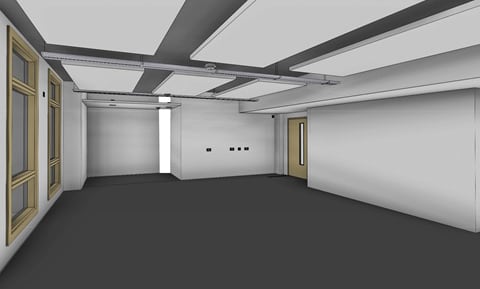- Client: Kent County Council
- Lead Contractor: Baxall Construction
- BIM Tools: Autodesk Revit, Navisworks
The £3.5m design and build, one form entry primary school functioned as a BIM proving ground for Kent County Council, providing valuable lessons in building services coordination, material cost take-offs and the value of a Common Data Environment.
The council’s original tender document requested that the project be carried out in BIM and a set of Employer’s Information Requirements was provided with the intention of one day enabling the building to be operated and maintained using BIM.
BIM protocols, standards and software formats were agreed at the outset and 3D models, with embedded data, were produced in Revit at RIBA Stage 3 by the main design partners, architect Hazle McCormack Young, main contractor Baxall Construction, and consulting building services engineer Crofton Design.
A CDE was not set up for the project. Instead, the latest versions of individual models were shared, either via the file sharing website Dropbox, or by email, once a week, and federated internally in Navisworks.
Chris Darby, associate electrical engineer at Crofton, comments: “A less formalised process was adopted, mainly because Baxall was at an early stage on its BIM journey. A key lesson learnt was the need to set up a CDE to improve collaboration, from the outset, and the contractor has since implemented the software Union Square for this purpose.”

BIM allowed Crofton to accurately visualise and organise the exposed services in the ceilings
Darby says designing in BIM vastly improved services coordination, enabling the M&E contractor (which did not itself design in BIM) to visualise and install systems at locations indicated in Crofton’s detailed model, rather than have to rely on 2D drawings. It also reduced the number of clashes between different services and between services and steelwork.
Around 60% of concrete soffits in the school are exposed, to increase thermal mass, leaving cable trays, ductwork and other services on view across all the classroom ceilings. BIM allowed Crofton to accurately visualise and organise the services to create a uniform and tidy appearance.
“Working in Revit rather than 2D CAD saved us several days work,” says Darby. “The architects designed the school so that all the classrooms are almost identical. Using the Revit Families function to import standard fixtures and fittings, once we had cracked one classroom, essentially, we had cracked them all.”
However, Crofton had to create a number of BIM objects from scratch due to a lack of available library objects, including sockets and data outlets, especially from smaller brands. Darby says this fact could preclude many smaller manufacturers, who may be more competitive on price, from winning work.

A number of BIM objects had to be created from scratch
At the opposite end of the scale, some firms provided BIM objects with far too much graphical detail, even to the extent of including a company logo, making them too cumbersome to use in models.
“No one needs to interrogate an object in that much detail and further along the design process when the model is more complete it can slow things down. One of the reasons we wished we had implemented a CDE was the amount of time it took to upload model files to Dropbox or email,” says Darby.
Baxall plugged BIM into Vico Office software to enable it to accurately assess the quantity of materials to order, including pipework, fittings and plasterboard, which helped cut costs and reduce waste.
However, calculating take-offs would have been more effective if the software’s specific requirements had been incorporated into the BIM Execution Plan, says Darby: “Vico Office requires elements in the model to be constructed in a certain way to enable automatic take-offs. For example, a wall should include the build up of brick, block and insulation etc.
“The architect had only modelled monolithic walls for Holborough, requiring Baxall to look back at the specification and input data on each of the components manually.”
The school was handed over, on time and to budget, at the end of the summer, thanks in part to the use of BIM. Going forward, COBie data drops for key equipment, including boilers and major plant, will be supplied to Kent County Council, although at present it is uncertain whether their facilities management team has the ability to interrogate the data.
“There is often an aspiration from clients to work in BIM, they know what information they want, but don’t necessarily what to do with it,” says Darby.
Baxall has now expanded its use of BIM, using it to programme construction activities, complete models early on to more accurately price jobs when tendering, and using Vico Office for more comprehensive costing exercises.
The architects designed the school so that all the classrooms are almost identical. Using the Revit Families function to import standard fixtures and fittings, once we had cracked one classroom, essentially, we had cracked them all.– Chris Darby, associate electrical engineer, Crofton
Comments
Comments are closed.














Excellent article and congratulations on a successful project. The message about manufacturer BIM content here is key and more should be done to promote issues and best practice when it comes to creating content.
I highlighted some reasons why manufacturer content gets over-looked here: http://www.craigsewell.co.uk/why-specifiers-ignore-your-bim-content/
This is great and exciting.
I have enjoyed and learnt a lot reading this article. As a Project management student I am curious to see a specific EIR and a BEP. Would someone help with this.
Regards
Vukile